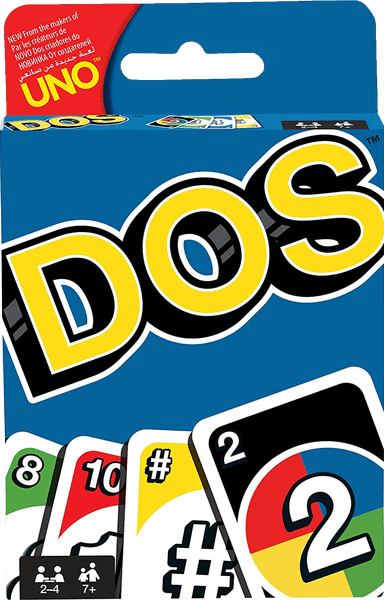DOS (2018) Board Game
DOS is a card game that was released in 2018 as a follow-up to the popular UNO game. Created by Nick Hayes and published by Mattel, Inc., DOS adds a new twist to the classic card game by introducing a new set of rules and gameplay mechanics.
Game Components of DOS
– 24 Blue cards: 3 each of 1, 3, 4, 5; 2 each of 6, 7, 8, 9, 10; 2 Wild cards
– 24 Green cards: 3 each of 1, 3, 4, 5; 2 each of 6, 7, 8, 9, 10; 2 Wild cards
– 24 Red cards: 3 each of 1, 3, 4, 5; 2 each of 6, 7, 8, 9, 10; 2 Wild cards
– 24 Yellow cards: 3 each of 1, 3, 4, 5; 2 each of 6, 7, 8, 9, 10; 2 Wild cards
– 12 Wild DOS™ cards.
How To Setup DOS
To set up DOS, each player draws a card, and the player with the highest number deals. The dealer shuffles the deck and deals seven cards to each player. Two cards are placed face-up in the middle to form the “Center Row,” with the deck beside them. The player to the left of the dealer starts the game.
Gameplay Mechanics and Game Objective
Player Experience
DOS is designed to be simple to learn but offers a bit more complexity than UNO, making it engaging for both children and adults. The game is quick, with rounds lasting just a few minutes. It encourages strategic thinking, particularly in combining cards to match numbers. Players appreciate the educational component, especially for younger children, as it helps teach basic addition skills.
Pros
Cons
Personal Thoughts on DOS
DOS is an excellent choice for families and casual gamers looking for a fun, quick game that adds a bit of strategy to the traditional card-matching genre. It’s particularly good for children as it helps with number recognition and basic arithmetic. For those who enjoy UNO but want something slightly more challenging, DOS is a great alternative. However, it may not be as appealing to players seeking highly complex or deeply strategic games.
We are supported by our audience. When you purchase through links on our site, we may earn an affiliate commission, at no extra cost for you. Learn more.

